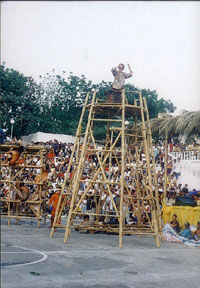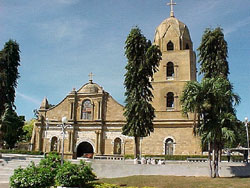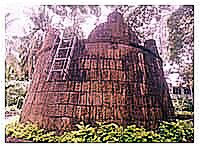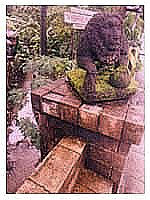Bantayan Festival: A historic adventure in Guimbal

Bantayan Tribe competition
* The colorful Bantayan Tribal Dance Drama Competition is on March 31
THERE is no better way to get to know the people of Guimbal than through their Bantayan Festival. It is the moment when the community strives to put on a splendid cultural presentation, not only for themselves but also for those who came from afar to admire and enjoy.
Its dramatic presentation and excitement, with greater preparations and more spectacular props each year is an attempt to save its historic event in danger of extinction. Its origin is the battle between the natives of Guimbal and the Muslim pirates. The format of the presentation is the theatrical enactment of the skirmishes and dances, the victory of the people in the community against the Muslim pirates, and finally homage to the patron saint.
Prominent in the presentation is the use of the prop guimba, believed to where the name of the town was derived from. It is an ancient instrument of the Spanish Panayanons that resembles a drum and is beaten by hand. This served as a warning to the community for an incoming raid.
TOWN ATTRACTIONS

Guimbal Catholic Church
Guimbal grew to be one of the provinces’ significant towns. The spread of Christianity in the area in 1703 and the increasing potential of Spain for trade and to gain wealth and somehow, prestige became common. Spaniards erected magnificent temples of worship; constructed an intricate network of burial sites, stone bridges and watchtowers. The town is recognized as one of the Iloilo’s most valuable cultural sites.
There are a number of watchtowers along the coast of southern Iloilo.
Mostly, their origin is from the Christian re-conquest with the purpose of securing their area for defense and to protect their peaceful community from Muslim marauders who were responsible for the looting of many communities and capturing the natives in the area and sell them as slaves in Kolambogan, Mindanao. Some have lasted for centuries with remarkable strength.

Bantayan or Kota watchtower
In the 17th century, Kota watchtowers were constructed in Barangays Tuguisan, C. Colon and Pescadores. They were placed at regular intervals so that alarm signals could be passed between them in case of attack, the towers were originally made of bamboos and were later built out of huge blocks of stones during the Spanish occupation. Easily visible from the spot, just a little way inland, they were at their most impressive with inner walls and outer walls and an ample space for watcher/s on its top.
A Kota watchtower has one entrance that is high up on its side and the only method of entrance and exit is through a ladder or rope. The areas of these three watchtowers vary greatly from 100 to 325 square meters.
The Roman Catholic Church of Guimbal is close by in the town plaza. It occupies an area of 1.22 hectares and was built in the 18th century. Its outside walls are made up of adobe blocks called igang. Its unique architecture makes it a magnet for tourists all year round.
Located at the town proper is the Spanish Arch Bridge or commonly known as Taytay Tigre. It measures 4.5 square meters and is considered as one of the shortest bridges constructed during the Spanish era.

Remains of Taytay Tigre
The people of Guimbal should be eternally grateful of these sites that possess significant historic and cultural value since Guimbalanons owe much to their rich history. It has flourished since its discovery in 1590 to the present. Its existence testify to the reality of the town’s vision and mission---a beautiful, healthy, progressive, peaceful, self-reliant, ecologically sustainable and globally competitive town geared towards the delivery of effective and efficient services through dynamic leadership for people empowerment and sustainable ecological balance. The rate of economic progress has been noticeably faster especially in the field of commerce, industry and tourism.
Get away from the hustle and bustle of Iloilo City, and take a 30-minuter drive to Guimbal, a fourth-class municipality belonging to the First District cluster is 29 kilometers east from the city of Iloilo and lies along the southern coastline of the province. The town shares a border with Tigbauan on the east; on the northeast by Tubungan; Igbaras on the northwest; and west by Miag-ao. It has a land area of 44.61 square kilometers and is made up of 33 villages.
INVITATION TO THE FESTIVAL
The festival is the celebration of the people and it never fails to draw visitors throughout the province and the other side of the region.
The municipality of Guimbal headed by their dynamic municipal mayor, Richard S. Garin is inviting everyone to celebrate with them the 2007 Bantayan Festival, which started yesterday with a Drum, Float, Street Dancing Competitions and the Search for Miss Bantayan Festival. The Porma Balas, Pinta Lawas, Fluvial Parade, the Re-enactment of the Moro Raid and the Bantayan Video Festival takes the limelight on March 29; and the colorful Bantayan Tribal Dance Drama Competition on March 31, 2007.
